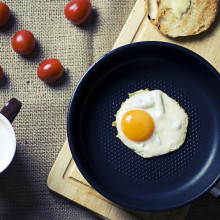Martin asked us "What's the science behind non-stick pans? What prevents the sticking?" To help out with this sticky situation, we spoke to Jess Wade, a materials scientist at Imperial College London, to get her take...
In this episode

00:00 - What makes a non-stick pan non-stick?
What makes a non-stick pan non-stick?
We had this question from Martin. To help out with this sticky situation, Adam Murphy spoke to Jess Wade, a materials scientist at Imperial College London, to get her take...
Adam - It’s a question that leaves people ‘stuck.’ Why does a single layer of black stuff on a pan turn it from an after dinner, eldritch cleaning nightmare to well, still a chore, but a much easier one?
On the forum, Tomassci says one word - Teflon. And they might be onto something.
To get the answer, we put the question to someone who wouldn’t ‘slip up,’ material scientist Jess Wade of Imperial College, London to see what she had to say.
Jess - In the 1930s, Roy Plunkett, a chemist at DuPont was trying to find a new refrigerant material. At the time, sulphur dioxide and ammonia were used in fridges but they were killing people in their homes.
One day Plunkett was making an alternative, a safer gas called tetrafluoroethylene and he stored it in super cold cylinders at -80 celsius. When he went to chlorinate it, he found out the gas wasn’t a gas anymore but had turned into a white powder which was resistant to heat, chemically inert, and super slippery. Although he had to saw the gas canister in half to find that out.
Adam - So, Plunkett had made a mistake, but like any good inventor he was about to turn it into something revolutionary.
Jess - Plunkett had created polytetrafluoroethylene, which we know today as Teflon. Metals that we make pans from like stainless steel aren't actually perfectly smooth. If we look at them with a microscope you actually see lots of cracks and holes. When the heat up, the metal expands, food seeps into the cracks, dries up and makes them tricky to clean.
Adam - As anyone who’s spent and evening scrubbing an old metal pot can attest to. But coating in in Teflon changes the game…
Jess - But if your pan is coated with Teflon the metal surface becomes much smoother. So smooth in fact, that geckos can’t stick to it, and geckos can even stick to glass. That’s because PTFE is made of long chains of fluorine and carbon really strongly bonded together. That means that they don’t want to interact with anything - even water.
Adam - Things that repel water like this are called hydrophobic. And it’s Teflon’s hydrophobic nature and really low friction that make it so non-stick.
Jess - Teflon’s not entirely perfect. If the temperature goes above 260 celsius, it starts to break apart, releasing fluorocarbons into the air. And if you cook mega-hot regularly, falkes of it can sneak off stopping your pan from being non-stick. Me and my dad love our non-stick pan.
Adam - And how does the Teflon stick onto the pan in the first place? Well, that bit’s easy. You just need to really really rough up the pan first.
Thank you to Jess for giving us something to ponder while we fry our breakfast.
And while we’re pondering, next week we’ll be answering this question from Geoff:
It’s often stated that there are more stars in the universe than there are grains of sand on all the beaches on Earth. My question is - who counted?
Related Content
- Previous Medicinal Cannabis: Weeding Out The Hype
- Next How are stars born?










Comments
Add a comment